Analysis of Business Environment for UK Supermarkets: Report
VerifiedAdded on 2020/07/23
|26
|6411
|53
Report
AI Summary
This report provides a comprehensive analysis of the UK business environment, with a specific focus on the supermarket sector. It begins by comparing different types of organizations, including profit, non-profit, and non-governmental organizations, highlighting their objectives, funding, and examples. The report then delves into the size and scope of organizations, differentiating between micro, small, medium, and large enterprises based on employee numbers, turnover, and market share. The organizational structure and function of these different types of businesses are also discussed. The report further examines the positive and negative impacts of the macro environment on business operations, followed by an internal and external analysis of the UK supermarket sector. It concludes by exploring the interrelation between strengths and weaknesses and external macro factors, providing insights into market share, profit share, and growth and sustainability within the industry. The report aims to provide a clear understanding of the business environment and its implications for the UK supermarket sector.
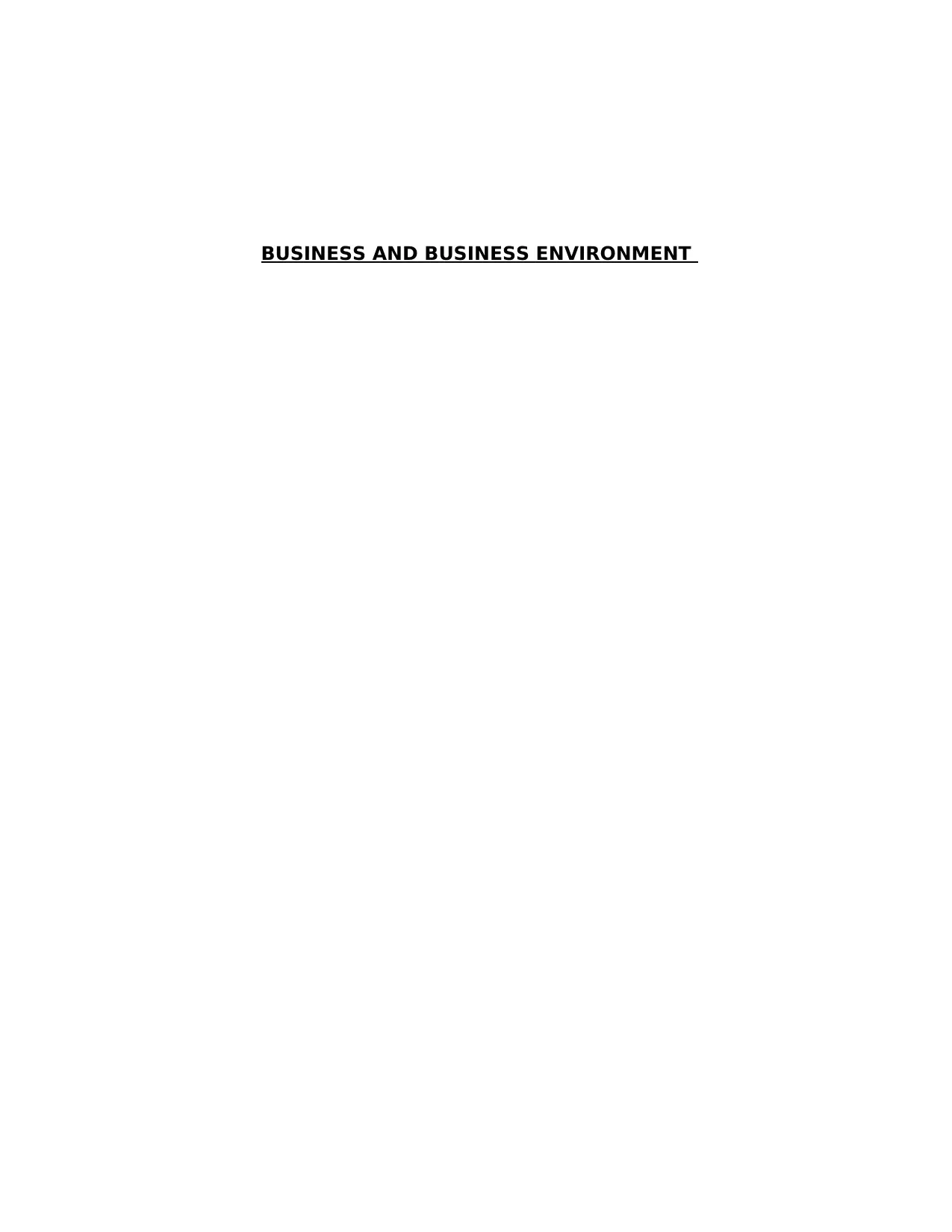
BUSINESS AND BUSINESS ENVIRONMENT
Paraphrase This Document
Need a fresh take? Get an instant paraphrase of this document with our AI Paraphraser
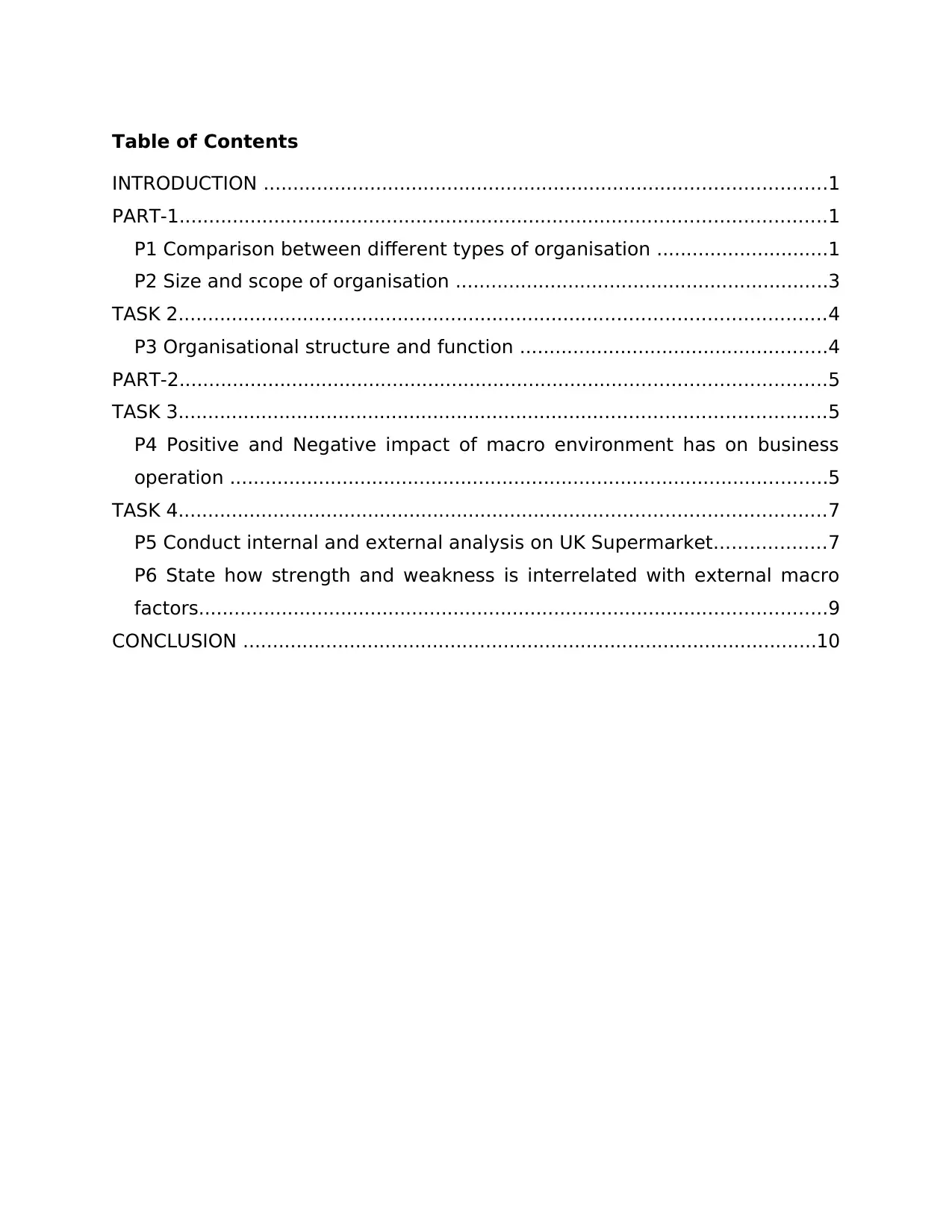
Table of Contents
INTRODUCTION ...............................................................................................1
PART-1.............................................................................................................1
P1 Comparison between different types of organisation .............................1
P2 Size and scope of organisation ...............................................................3
TASK 2.............................................................................................................4
P3 Organisational structure and function ....................................................4
PART-2.............................................................................................................5
TASK 3.............................................................................................................5
P4 Positive and Negative impact of macro environment has on business
operation .....................................................................................................5
TASK 4.............................................................................................................7
P5 Conduct internal and external analysis on UK Supermarket...................7
P6 State how strength and weakness is interrelated with external macro
factors..........................................................................................................9
CONCLUSION .................................................................................................10
INTRODUCTION ...............................................................................................1
PART-1.............................................................................................................1
P1 Comparison between different types of organisation .............................1
P2 Size and scope of organisation ...............................................................3
TASK 2.............................................................................................................4
P3 Organisational structure and function ....................................................4
PART-2.............................................................................................................5
TASK 3.............................................................................................................5
P4 Positive and Negative impact of macro environment has on business
operation .....................................................................................................5
TASK 4.............................................................................................................7
P5 Conduct internal and external analysis on UK Supermarket...................7
P6 State how strength and weakness is interrelated with external macro
factors..........................................................................................................9
CONCLUSION .................................................................................................10
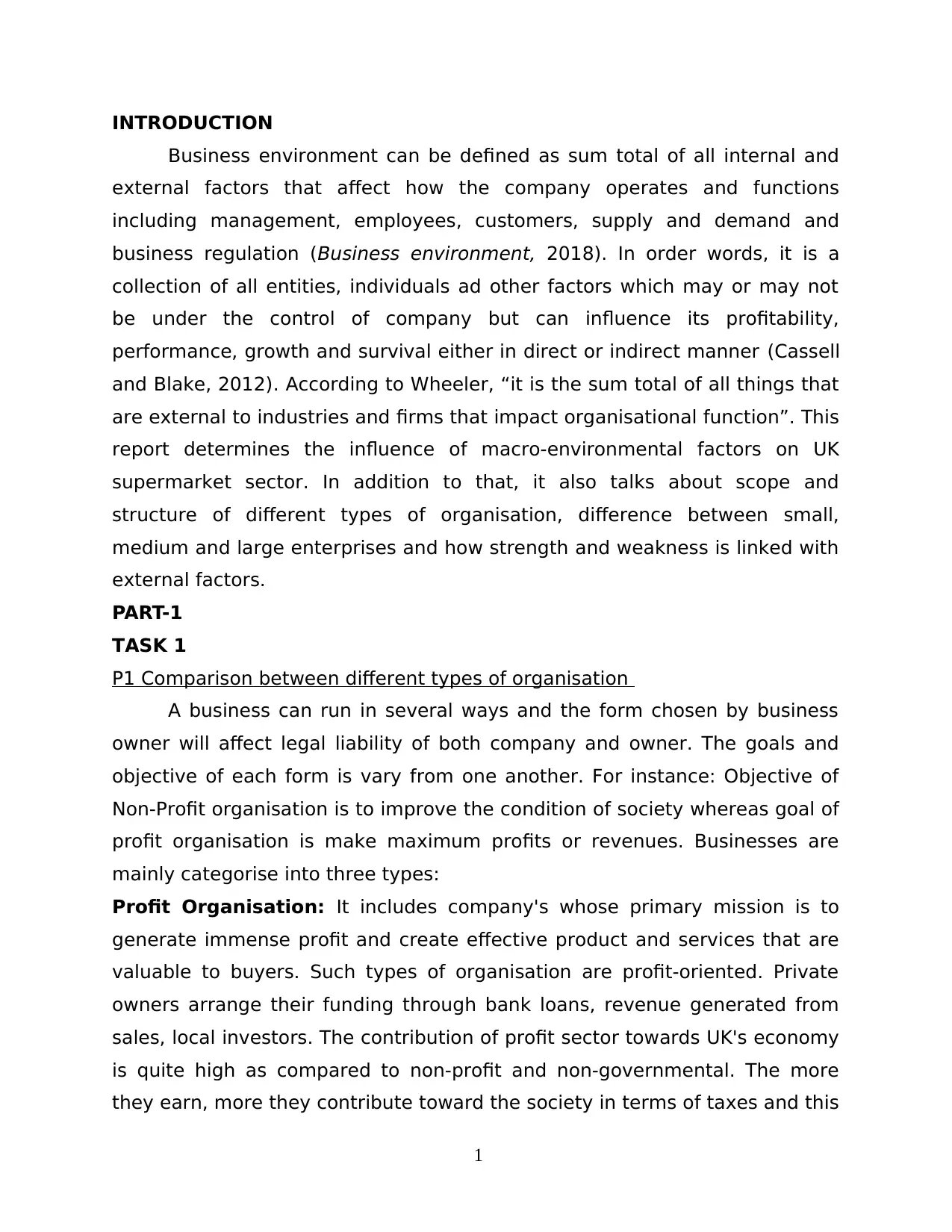
INTRODUCTION
Business environment can be defined as sum total of all internal and
external factors that affect how the company operates and functions
including management, employees, customers, supply and demand and
business regulation (Business environment, 2018). In order words, it is a
collection of all entities, individuals ad other factors which may or may not
be under the control of company but can influence its profitability,
performance, growth and survival either in direct or indirect manner (Cassell
and Blake, 2012). According to Wheeler, “it is the sum total of all things that
are external to industries and firms that impact organisational function”. This
report determines the influence of macro-environmental factors on UK
supermarket sector. In addition to that, it also talks about scope and
structure of different types of organisation, difference between small,
medium and large enterprises and how strength and weakness is linked with
external factors.
PART-1
TASK 1
P1 Comparison between different types of organisation
A business can run in several ways and the form chosen by business
owner will affect legal liability of both company and owner. The goals and
objective of each form is vary from one another. For instance: Objective of
Non-Profit organisation is to improve the condition of society whereas goal of
profit organisation is make maximum profits or revenues. Businesses are
mainly categorise into three types:
Profit Organisation: It includes company's whose primary mission is to
generate immense profit and create effective product and services that are
valuable to buyers. Such types of organisation are profit-oriented. Private
owners arrange their funding through bank loans, revenue generated from
sales, local investors. The contribution of profit sector towards UK's economy
is quite high as compared to non-profit and non-governmental. The more
they earn, more they contribute toward the society in terms of taxes and this
1
Business environment can be defined as sum total of all internal and
external factors that affect how the company operates and functions
including management, employees, customers, supply and demand and
business regulation (Business environment, 2018). In order words, it is a
collection of all entities, individuals ad other factors which may or may not
be under the control of company but can influence its profitability,
performance, growth and survival either in direct or indirect manner (Cassell
and Blake, 2012). According to Wheeler, “it is the sum total of all things that
are external to industries and firms that impact organisational function”. This
report determines the influence of macro-environmental factors on UK
supermarket sector. In addition to that, it also talks about scope and
structure of different types of organisation, difference between small,
medium and large enterprises and how strength and weakness is linked with
external factors.
PART-1
TASK 1
P1 Comparison between different types of organisation
A business can run in several ways and the form chosen by business
owner will affect legal liability of both company and owner. The goals and
objective of each form is vary from one another. For instance: Objective of
Non-Profit organisation is to improve the condition of society whereas goal of
profit organisation is make maximum profits or revenues. Businesses are
mainly categorise into three types:
Profit Organisation: It includes company's whose primary mission is to
generate immense profit and create effective product and services that are
valuable to buyers. Such types of organisation are profit-oriented. Private
owners arrange their funding through bank loans, revenue generated from
sales, local investors. The contribution of profit sector towards UK's economy
is quite high as compared to non-profit and non-governmental. The more
they earn, more they contribute toward the society in terms of taxes and this
1
⊘ This is a preview!⊘
Do you want full access?
Subscribe today to unlock all pages.

Trusted by 1+ million students worldwide
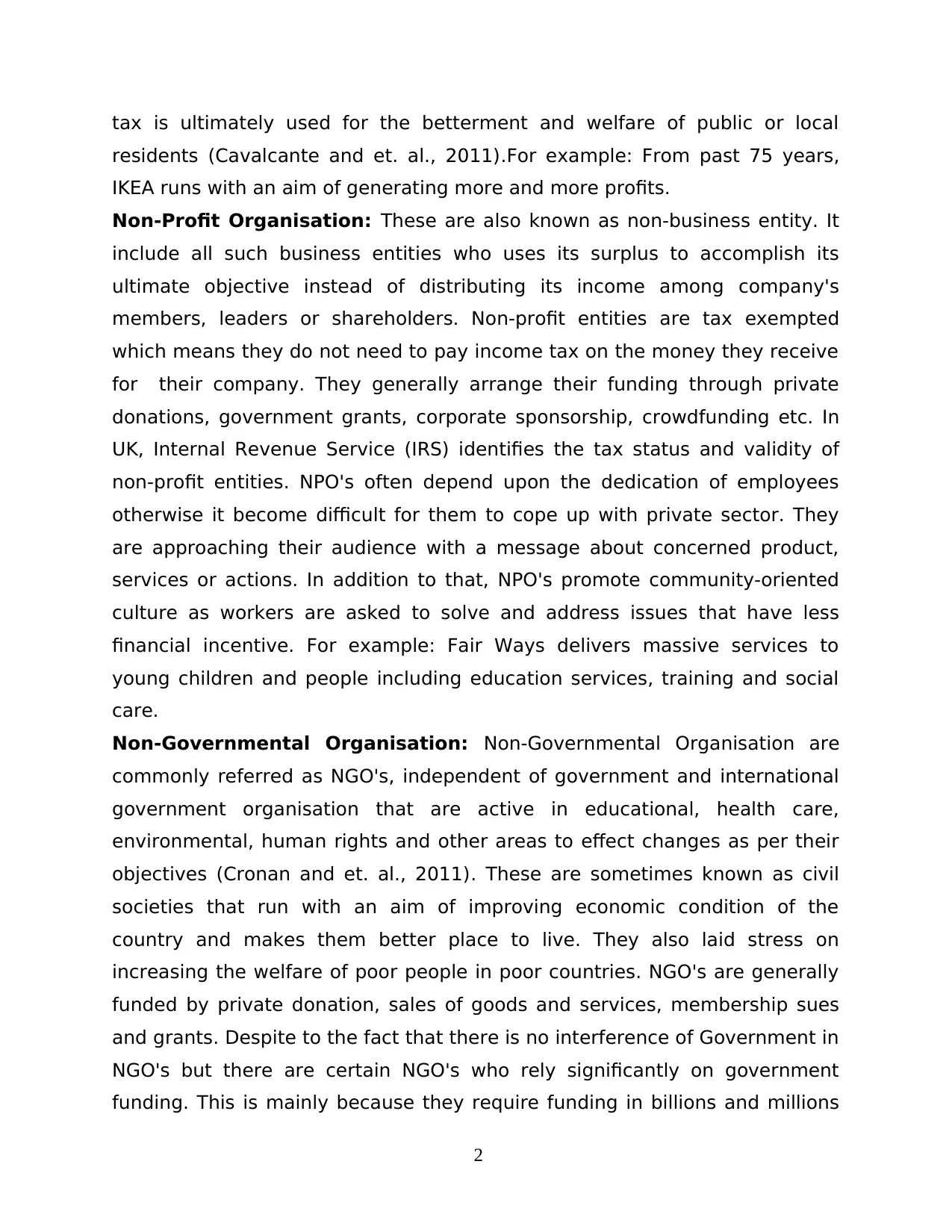
tax is ultimately used for the betterment and welfare of public or local
residents (Cavalcante and et. al., 2011).For example: From past 75 years,
IKEA runs with an aim of generating more and more profits.
Non-Profit Organisation: These are also known as non-business entity. It
include all such business entities who uses its surplus to accomplish its
ultimate objective instead of distributing its income among company's
members, leaders or shareholders. Non-profit entities are tax exempted
which means they do not need to pay income tax on the money they receive
for their company. They generally arrange their funding through private
donations, government grants, corporate sponsorship, crowdfunding etc. In
UK, Internal Revenue Service (IRS) identifies the tax status and validity of
non-profit entities. NPO's often depend upon the dedication of employees
otherwise it become difficult for them to cope up with private sector. They
are approaching their audience with a message about concerned product,
services or actions. In addition to that, NPO's promote community-oriented
culture as workers are asked to solve and address issues that have less
financial incentive. For example: Fair Ways delivers massive services to
young children and people including education services, training and social
care.
Non-Governmental Organisation: Non-Governmental Organisation are
commonly referred as NGO's, independent of government and international
government organisation that are active in educational, health care,
environmental, human rights and other areas to effect changes as per their
objectives (Cronan and et. al., 2011). These are sometimes known as civil
societies that run with an aim of improving economic condition of the
country and makes them better place to live. They also laid stress on
increasing the welfare of poor people in poor countries. NGO's are generally
funded by private donation, sales of goods and services, membership sues
and grants. Despite to the fact that there is no interference of Government in
NGO's but there are certain NGO's who rely significantly on government
funding. This is mainly because they require funding in billions and millions
2
residents (Cavalcante and et. al., 2011).For example: From past 75 years,
IKEA runs with an aim of generating more and more profits.
Non-Profit Organisation: These are also known as non-business entity. It
include all such business entities who uses its surplus to accomplish its
ultimate objective instead of distributing its income among company's
members, leaders or shareholders. Non-profit entities are tax exempted
which means they do not need to pay income tax on the money they receive
for their company. They generally arrange their funding through private
donations, government grants, corporate sponsorship, crowdfunding etc. In
UK, Internal Revenue Service (IRS) identifies the tax status and validity of
non-profit entities. NPO's often depend upon the dedication of employees
otherwise it become difficult for them to cope up with private sector. They
are approaching their audience with a message about concerned product,
services or actions. In addition to that, NPO's promote community-oriented
culture as workers are asked to solve and address issues that have less
financial incentive. For example: Fair Ways delivers massive services to
young children and people including education services, training and social
care.
Non-Governmental Organisation: Non-Governmental Organisation are
commonly referred as NGO's, independent of government and international
government organisation that are active in educational, health care,
environmental, human rights and other areas to effect changes as per their
objectives (Cronan and et. al., 2011). These are sometimes known as civil
societies that run with an aim of improving economic condition of the
country and makes them better place to live. They also laid stress on
increasing the welfare of poor people in poor countries. NGO's are generally
funded by private donation, sales of goods and services, membership sues
and grants. Despite to the fact that there is no interference of Government in
NGO's but there are certain NGO's who rely significantly on government
funding. This is mainly because they require funding in billions and millions
2
Paraphrase This Document
Need a fresh take? Get an instant paraphrase of this document with our AI Paraphraser
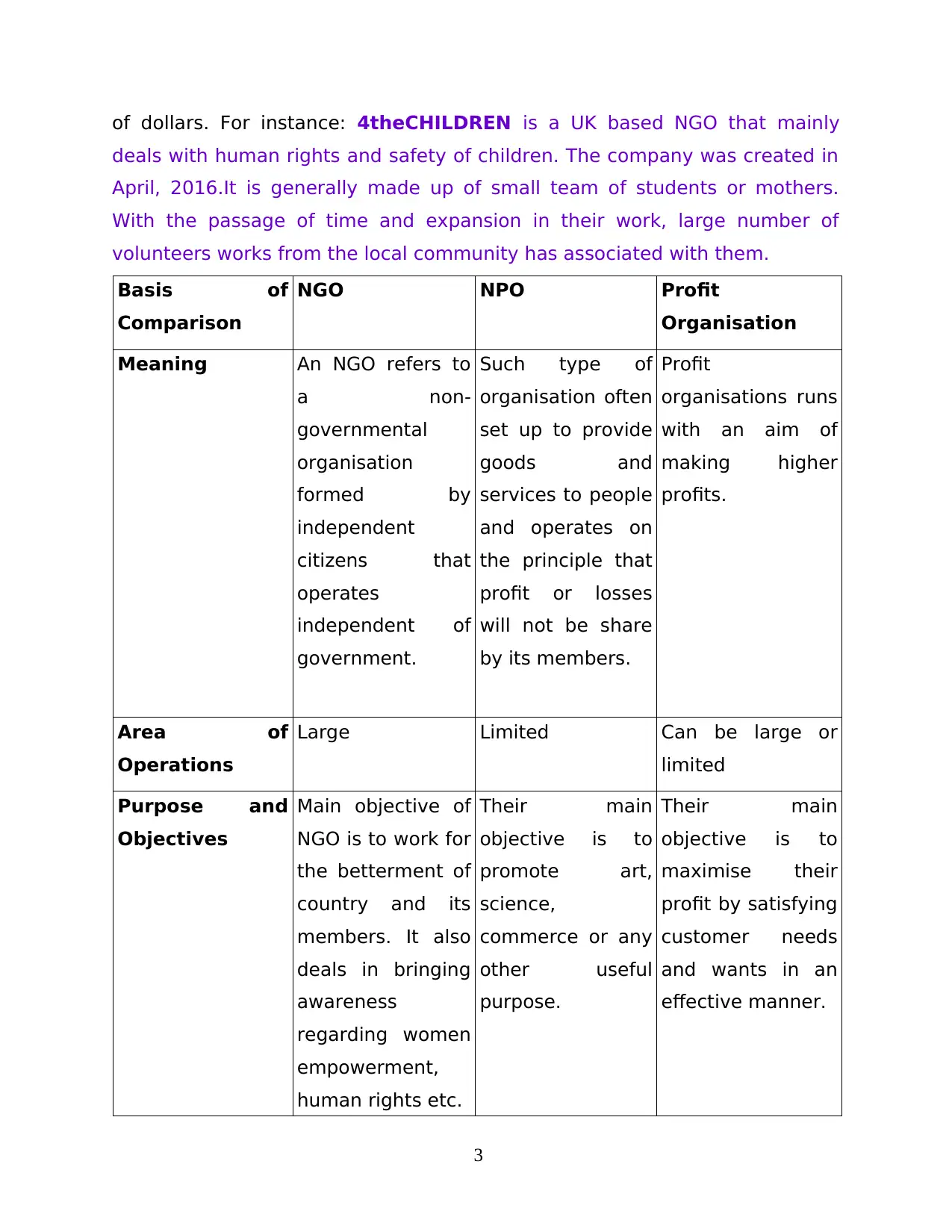
of dollars. For instance: 4theCHILDREN is a UK based NGO that mainly
deals with human rights and safety of children. The company was created in
April, 2016.It is generally made up of small team of students or mothers.
With the passage of time and expansion in their work, large number of
volunteers works from the local community has associated with them.
Basis of
Comparison
NGO NPO Profit
Organisation
Meaning An NGO refers to
a non-
governmental
organisation
formed by
independent
citizens that
operates
independent of
government.
Such type of
organisation often
set up to provide
goods and
services to people
and operates on
the principle that
profit or losses
will not be share
by its members.
Profit
organisations runs
with an aim of
making higher
profits.
Area of
Operations
Large Limited Can be large or
limited
Purpose and
Objectives
Main objective of
NGO is to work for
the betterment of
country and its
members. It also
deals in bringing
awareness
regarding women
empowerment,
human rights etc.
Their main
objective is to
promote art,
science,
commerce or any
other useful
purpose.
Their main
objective is to
maximise their
profit by satisfying
customer needs
and wants in an
effective manner.
3
deals with human rights and safety of children. The company was created in
April, 2016.It is generally made up of small team of students or mothers.
With the passage of time and expansion in their work, large number of
volunteers works from the local community has associated with them.
Basis of
Comparison
NGO NPO Profit
Organisation
Meaning An NGO refers to
a non-
governmental
organisation
formed by
independent
citizens that
operates
independent of
government.
Such type of
organisation often
set up to provide
goods and
services to people
and operates on
the principle that
profit or losses
will not be share
by its members.
Profit
organisations runs
with an aim of
making higher
profits.
Area of
Operations
Large Limited Can be large or
limited
Purpose and
Objectives
Main objective of
NGO is to work for
the betterment of
country and its
members. It also
deals in bringing
awareness
regarding women
empowerment,
human rights etc.
Their main
objective is to
promote art,
science,
commerce or any
other useful
purpose.
Their main
objective is to
maximise their
profit by satisfying
customer needs
and wants in an
effective manner.
3
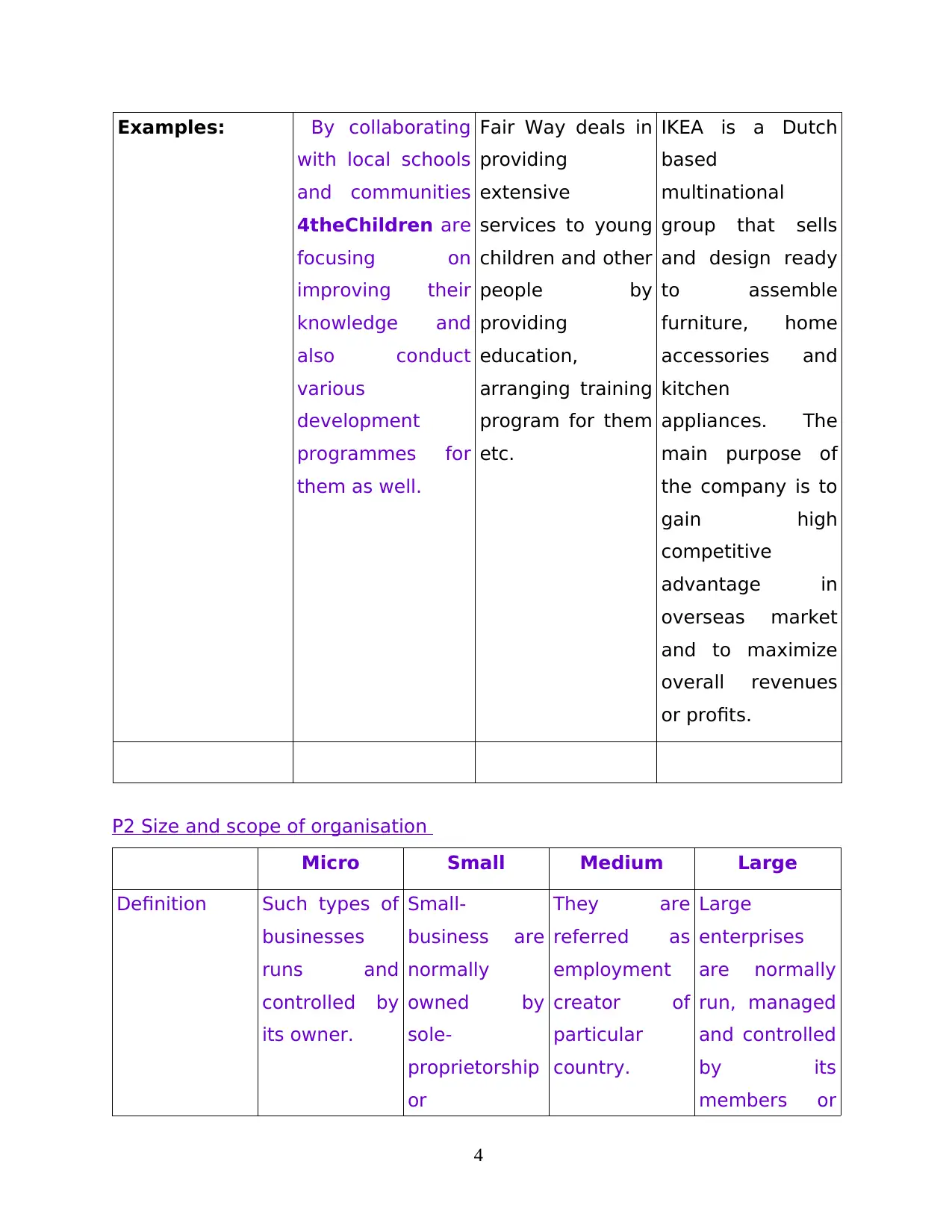
Examples: By collaborating
with local schools
and communities
4theChildren are
focusing on
improving their
knowledge and
also conduct
various
development
programmes for
them as well.
Fair Way deals in
providing
extensive
services to young
children and other
people by
providing
education,
arranging training
program for them
etc.
IKEA is a Dutch
based
multinational
group that sells
and design ready
to assemble
furniture, home
accessories and
kitchen
appliances. The
main purpose of
the company is to
gain high
competitive
advantage in
overseas market
and to maximize
overall revenues
or profits.
P2 Size and scope of organisation
Micro Small Medium Large
Definition Such types of
businesses
runs and
controlled by
its owner.
Small-
business are
normally
owned by
sole-
proprietorship
or
They are
referred as
employment
creator of
particular
country.
Large
enterprises
are normally
run, managed
and controlled
by its
members or
4
with local schools
and communities
4theChildren are
focusing on
improving their
knowledge and
also conduct
various
development
programmes for
them as well.
Fair Way deals in
providing
extensive
services to young
children and other
people by
providing
education,
arranging training
program for them
etc.
IKEA is a Dutch
based
multinational
group that sells
and design ready
to assemble
furniture, home
accessories and
kitchen
appliances. The
main purpose of
the company is to
gain high
competitive
advantage in
overseas market
and to maximize
overall revenues
or profits.
P2 Size and scope of organisation
Micro Small Medium Large
Definition Such types of
businesses
runs and
controlled by
its owner.
Small-
business are
normally
owned by
sole-
proprietorship
or
They are
referred as
employment
creator of
particular
country.
Large
enterprises
are normally
run, managed
and controlled
by its
members or
4
⊘ This is a preview!⊘
Do you want full access?
Subscribe today to unlock all pages.

Trusted by 1+ million students worldwide
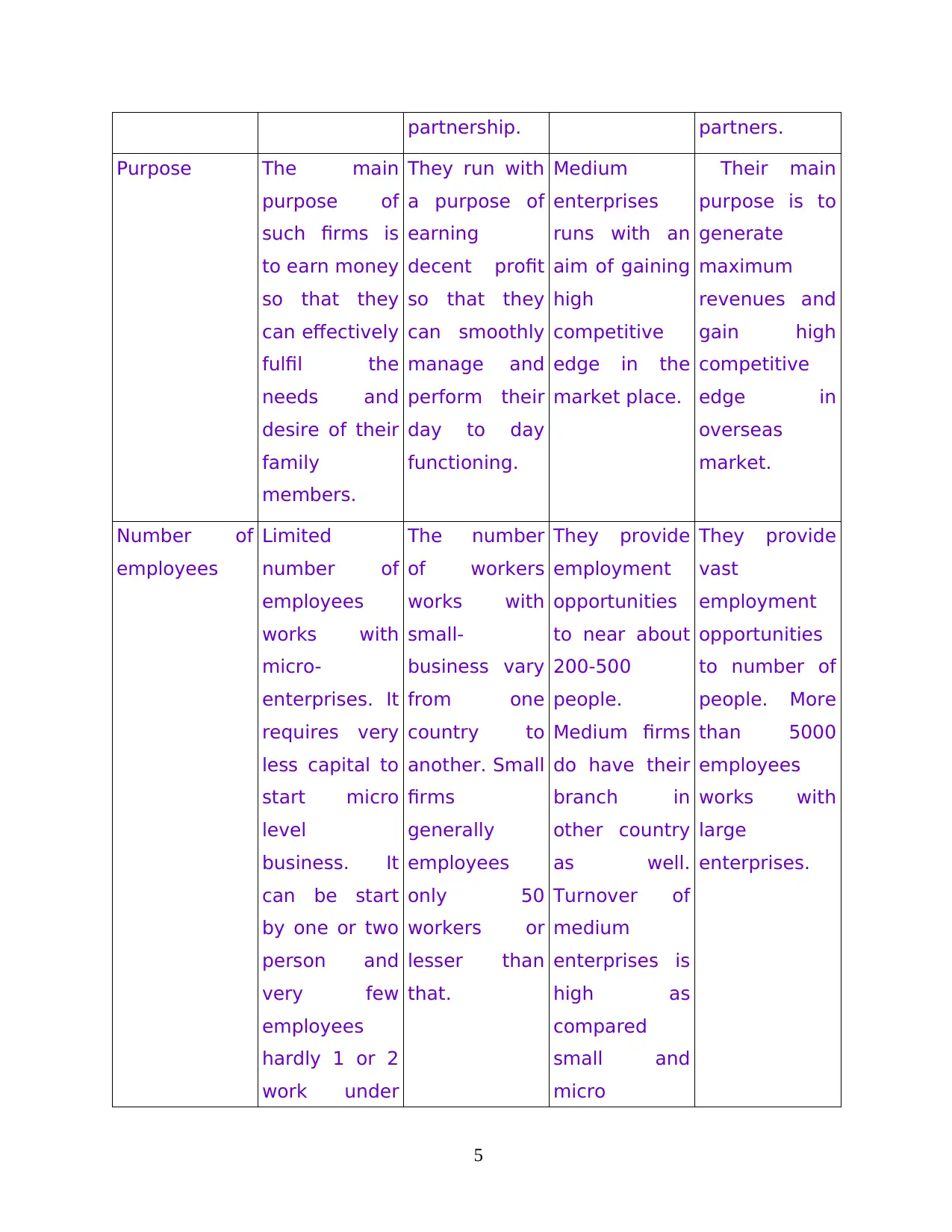
partnership. partners.
Purpose The main
purpose of
such firms is
to earn money
so that they
can effectively
fulfil the
needs and
desire of their
family
members.
They run with
a purpose of
earning
decent profit
so that they
can smoothly
manage and
perform their
day to day
functioning.
Medium
enterprises
runs with an
aim of gaining
high
competitive
edge in the
market place.
Their main
purpose is to
generate
maximum
revenues and
gain high
competitive
edge in
overseas
market.
Number of
employees
Limited
number of
employees
works with
micro-
enterprises. It
requires very
less capital to
start micro
level
business. It
can be start
by one or two
person and
very few
employees
hardly 1 or 2
work under
The number
of workers
works with
small-
business vary
from one
country to
another. Small
firms
generally
employees
only 50
workers or
lesser than
that.
They provide
employment
opportunities
to near about
200-500
people.
Medium firms
do have their
branch in
other country
as well.
Turnover of
medium
enterprises is
high as
compared
small and
micro
They provide
vast
employment
opportunities
to number of
people. More
than 5000
employees
works with
large
enterprises.
5
Purpose The main
purpose of
such firms is
to earn money
so that they
can effectively
fulfil the
needs and
desire of their
family
members.
They run with
a purpose of
earning
decent profit
so that they
can smoothly
manage and
perform their
day to day
functioning.
Medium
enterprises
runs with an
aim of gaining
high
competitive
edge in the
market place.
Their main
purpose is to
generate
maximum
revenues and
gain high
competitive
edge in
overseas
market.
Number of
employees
Limited
number of
employees
works with
micro-
enterprises. It
requires very
less capital to
start micro
level
business. It
can be start
by one or two
person and
very few
employees
hardly 1 or 2
work under
The number
of workers
works with
small-
business vary
from one
country to
another. Small
firms
generally
employees
only 50
workers or
lesser than
that.
They provide
employment
opportunities
to near about
200-500
people.
Medium firms
do have their
branch in
other country
as well.
Turnover of
medium
enterprises is
high as
compared
small and
micro
They provide
vast
employment
opportunities
to number of
people. More
than 5000
employees
works with
large
enterprises.
5
Paraphrase This Document
Need a fresh take? Get an instant paraphrase of this document with our AI Paraphraser
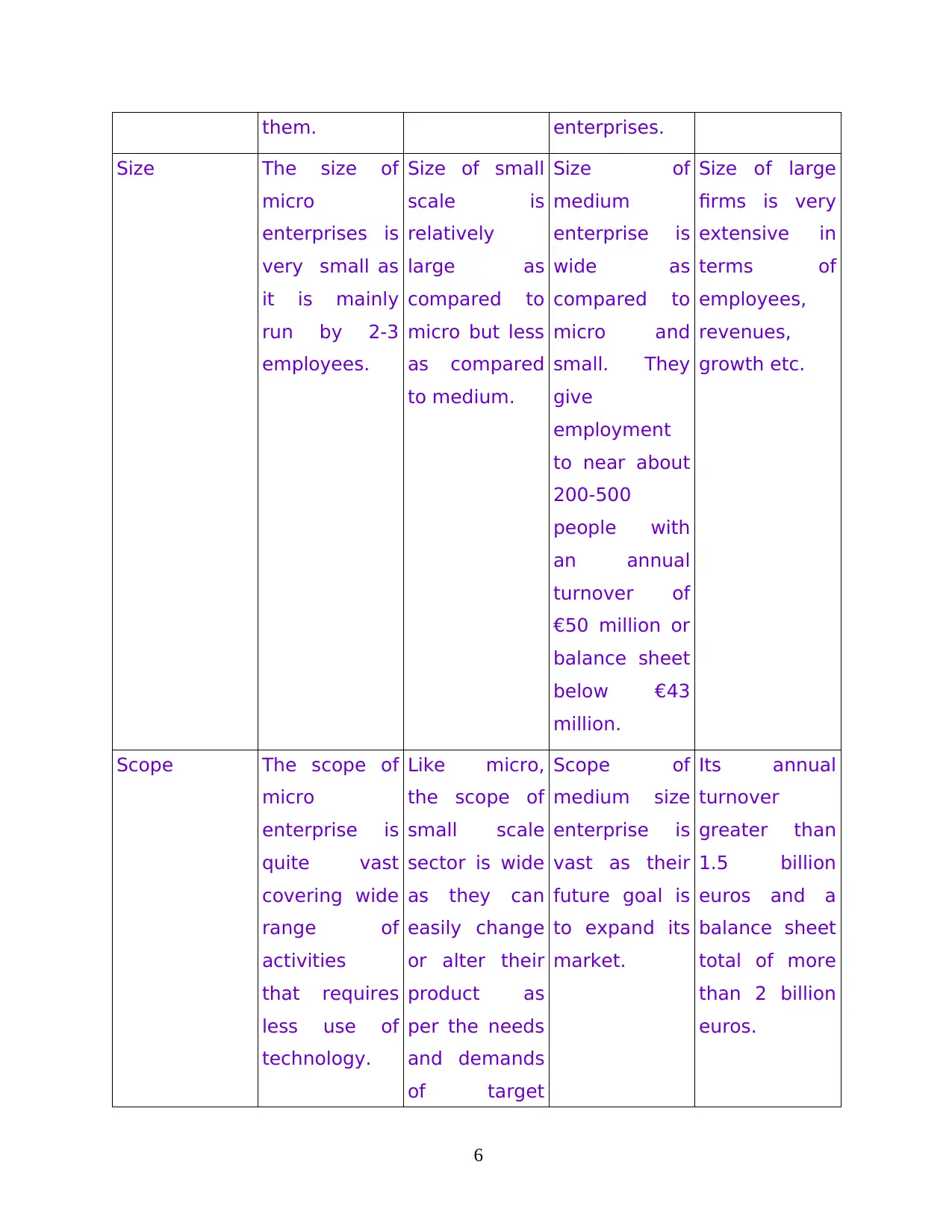
them. enterprises.
Size The size of
micro
enterprises is
very small as
it is mainly
run by 2-3
employees.
Size of small
scale is
relatively
large as
compared to
micro but less
as compared
to medium.
Size of
medium
enterprise is
wide as
compared to
micro and
small. They
give
employment
to near about
200-500
people with
an annual
turnover of
€50 million or
balance sheet
below €43
million.
Size of large
firms is very
extensive in
terms of
employees,
revenues,
growth etc.
Scope The scope of
micro
enterprise is
quite vast
covering wide
range of
activities
that requires
less use of
technology.
Like micro,
the scope of
small scale
sector is wide
as they can
easily change
or alter their
product as
per the needs
and demands
of target
Scope of
medium size
enterprise is
vast as their
future goal is
to expand its
market.
Its annual
turnover
greater than
1.5 billion
euros and a
balance sheet
total of more
than 2 billion
euros.
6
Size The size of
micro
enterprises is
very small as
it is mainly
run by 2-3
employees.
Size of small
scale is
relatively
large as
compared to
micro but less
as compared
to medium.
Size of
medium
enterprise is
wide as
compared to
micro and
small. They
give
employment
to near about
200-500
people with
an annual
turnover of
€50 million or
balance sheet
below €43
million.
Size of large
firms is very
extensive in
terms of
employees,
revenues,
growth etc.
Scope The scope of
micro
enterprise is
quite vast
covering wide
range of
activities
that requires
less use of
technology.
Like micro,
the scope of
small scale
sector is wide
as they can
easily change
or alter their
product as
per the needs
and demands
of target
Scope of
medium size
enterprise is
vast as their
future goal is
to expand its
market.
Its annual
turnover
greater than
1.5 billion
euros and a
balance sheet
total of more
than 2 billion
euros.
6
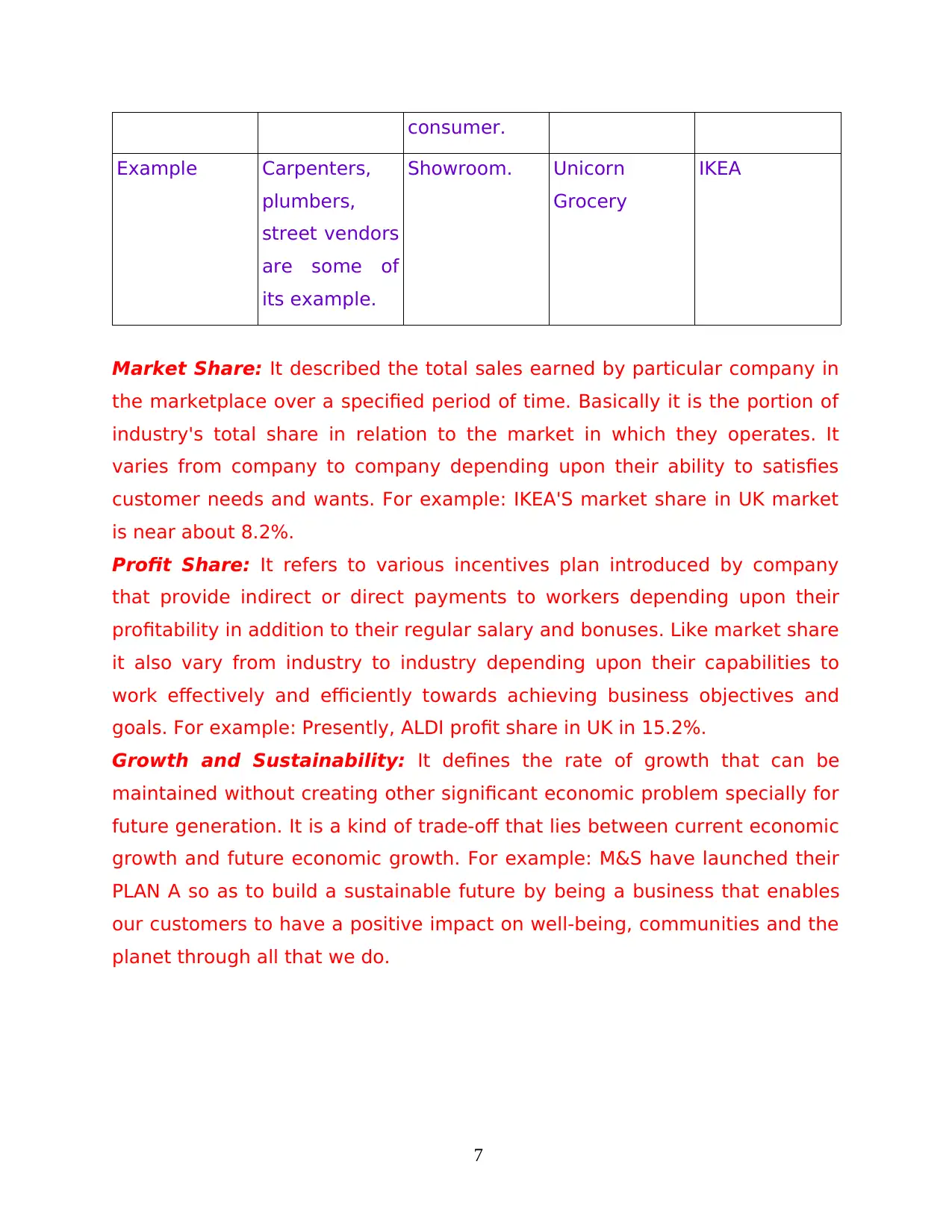
consumer.
Example Carpenters,
plumbers,
street vendors
are some of
its example.
Showroom. Unicorn
Grocery
IKEA
Market Share: It described the total sales earned by particular company in
the marketplace over a specified period of time. Basically it is the portion of
industry's total share in relation to the market in which they operates. It
varies from company to company depending upon their ability to satisfies
customer needs and wants. For example: IKEA'S market share in UK market
is near about 8.2%.
Profit Share: It refers to various incentives plan introduced by company
that provide indirect or direct payments to workers depending upon their
profitability in addition to their regular salary and bonuses. Like market share
it also vary from industry to industry depending upon their capabilities to
work effectively and efficiently towards achieving business objectives and
goals. For example: Presently, ALDI profit share in UK in 15.2%.
Growth and Sustainability: It defines the rate of growth that can be
maintained without creating other significant economic problem specially for
future generation. It is a kind of trade-off that lies between current economic
growth and future economic growth. For example: M&S have launched their
PLAN A so as to build a sustainable future by being a business that enables
our customers to have a positive impact on well-being, communities and the
planet through all that we do.
7
Example Carpenters,
plumbers,
street vendors
are some of
its example.
Showroom. Unicorn
Grocery
IKEA
Market Share: It described the total sales earned by particular company in
the marketplace over a specified period of time. Basically it is the portion of
industry's total share in relation to the market in which they operates. It
varies from company to company depending upon their ability to satisfies
customer needs and wants. For example: IKEA'S market share in UK market
is near about 8.2%.
Profit Share: It refers to various incentives plan introduced by company
that provide indirect or direct payments to workers depending upon their
profitability in addition to their regular salary and bonuses. Like market share
it also vary from industry to industry depending upon their capabilities to
work effectively and efficiently towards achieving business objectives and
goals. For example: Presently, ALDI profit share in UK in 15.2%.
Growth and Sustainability: It defines the rate of growth that can be
maintained without creating other significant economic problem specially for
future generation. It is a kind of trade-off that lies between current economic
growth and future economic growth. For example: M&S have launched their
PLAN A so as to build a sustainable future by being a business that enables
our customers to have a positive impact on well-being, communities and the
planet through all that we do.
7
⊘ This is a preview!⊘
Do you want full access?
Subscribe today to unlock all pages.

Trusted by 1+ million students worldwide
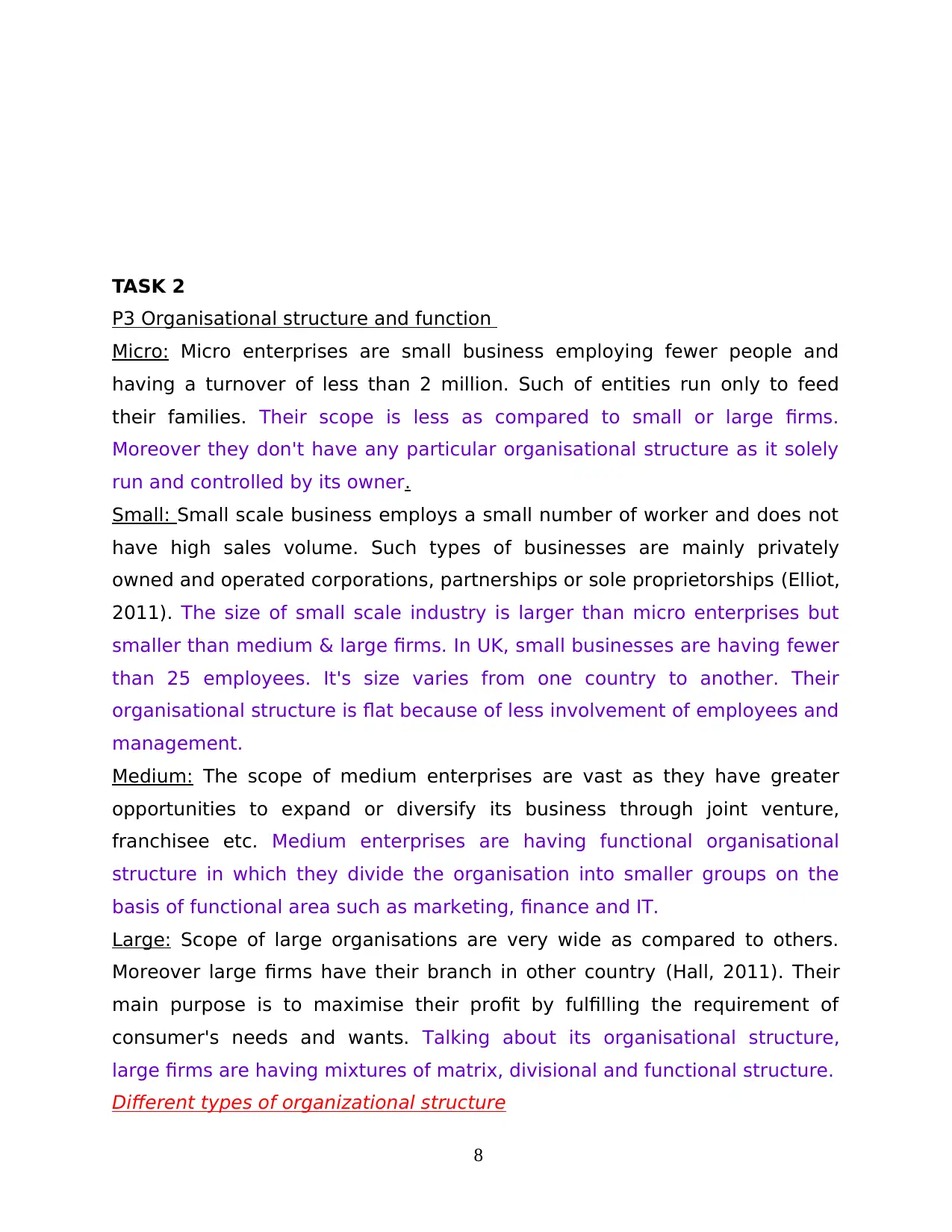
TASK 2
P3 Organisational structure and function
Micro: Micro enterprises are small business employing fewer people and
having a turnover of less than 2 million. Such of entities run only to feed
their families. Their scope is less as compared to small or large firms.
Moreover they don't have any particular organisational structure as it solely
run and controlled by its owner.
Small: Small scale business employs a small number of worker and does not
have high sales volume. Such types of businesses are mainly privately
owned and operated corporations, partnerships or sole proprietorships (Elliot,
2011). The size of small scale industry is larger than micro enterprises but
smaller than medium & large firms. In UK, small businesses are having fewer
than 25 employees. It's size varies from one country to another. Their
organisational structure is flat because of less involvement of employees and
management.
Medium: The scope of medium enterprises are vast as they have greater
opportunities to expand or diversify its business through joint venture,
franchisee etc. Medium enterprises are having functional organisational
structure in which they divide the organisation into smaller groups on the
basis of functional area such as marketing, finance and IT.
Large: Scope of large organisations are very wide as compared to others.
Moreover large firms have their branch in other country (Hall, 2011). Their
main purpose is to maximise their profit by fulfilling the requirement of
consumer's needs and wants. Talking about its organisational structure,
large firms are having mixtures of matrix, divisional and functional structure.
Different types of organizational structure
8
P3 Organisational structure and function
Micro: Micro enterprises are small business employing fewer people and
having a turnover of less than 2 million. Such of entities run only to feed
their families. Their scope is less as compared to small or large firms.
Moreover they don't have any particular organisational structure as it solely
run and controlled by its owner.
Small: Small scale business employs a small number of worker and does not
have high sales volume. Such types of businesses are mainly privately
owned and operated corporations, partnerships or sole proprietorships (Elliot,
2011). The size of small scale industry is larger than micro enterprises but
smaller than medium & large firms. In UK, small businesses are having fewer
than 25 employees. It's size varies from one country to another. Their
organisational structure is flat because of less involvement of employees and
management.
Medium: The scope of medium enterprises are vast as they have greater
opportunities to expand or diversify its business through joint venture,
franchisee etc. Medium enterprises are having functional organisational
structure in which they divide the organisation into smaller groups on the
basis of functional area such as marketing, finance and IT.
Large: Scope of large organisations are very wide as compared to others.
Moreover large firms have their branch in other country (Hall, 2011). Their
main purpose is to maximise their profit by fulfilling the requirement of
consumer's needs and wants. Talking about its organisational structure,
large firms are having mixtures of matrix, divisional and functional structure.
Different types of organizational structure
8
Paraphrase This Document
Need a fresh take? Get an instant paraphrase of this document with our AI Paraphraser
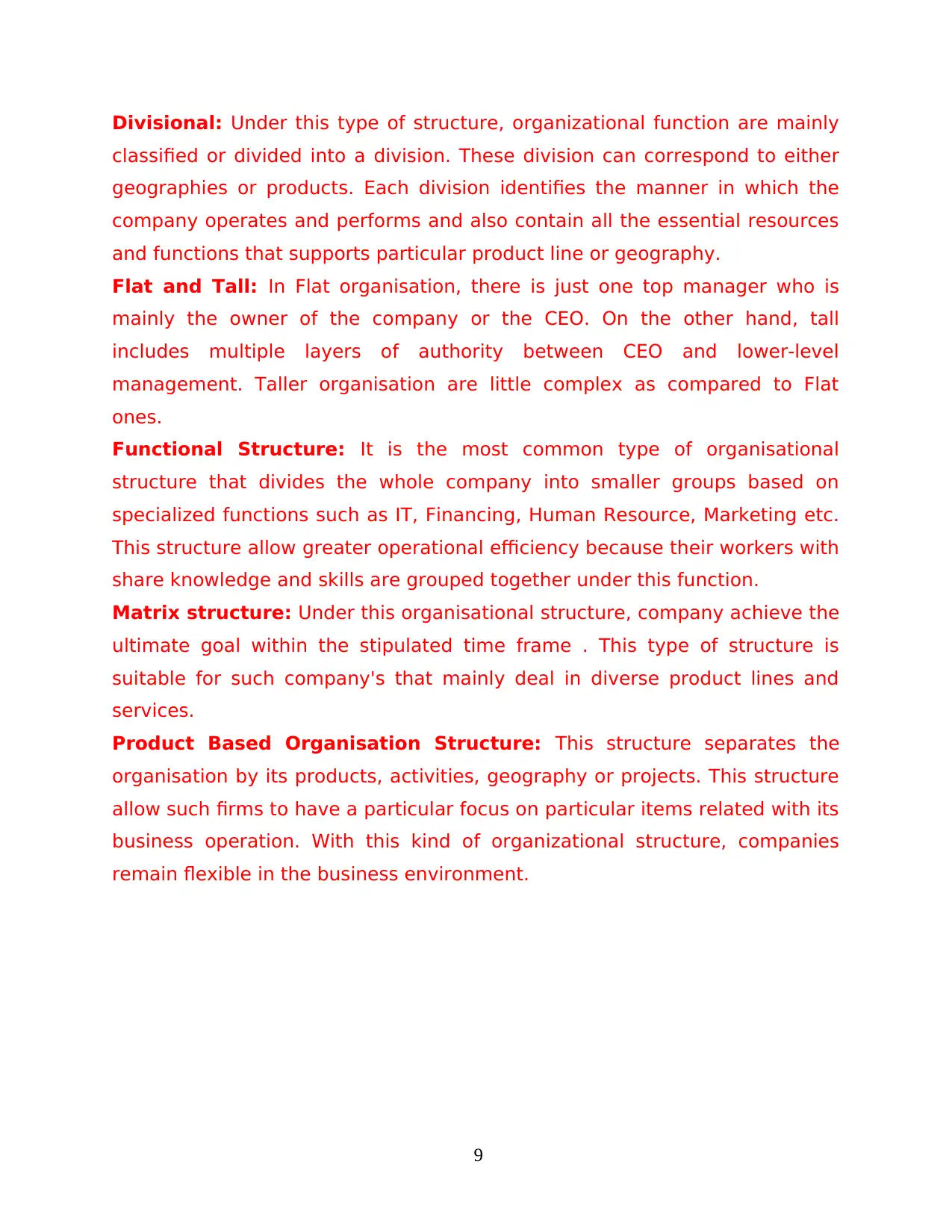
Divisional: Under this type of structure, organizational function are mainly
classified or divided into a division. These division can correspond to either
geographies or products. Each division identifies the manner in which the
company operates and performs and also contain all the essential resources
and functions that supports particular product line or geography.
Flat and Tall: In Flat organisation, there is just one top manager who is
mainly the owner of the company or the CEO. On the other hand, tall
includes multiple layers of authority between CEO and lower-level
management. Taller organisation are little complex as compared to Flat
ones.
Functional Structure: It is the most common type of organisational
structure that divides the whole company into smaller groups based on
specialized functions such as IT, Financing, Human Resource, Marketing etc.
This structure allow greater operational efficiency because their workers with
share knowledge and skills are grouped together under this function.
Matrix structure: Under this organisational structure, company achieve the
ultimate goal within the stipulated time frame . This type of structure is
suitable for such company's that mainly deal in diverse product lines and
services.
Product Based Organisation Structure: This structure separates the
organisation by its products, activities, geography or projects. This structure
allow such firms to have a particular focus on particular items related with its
business operation. With this kind of organizational structure, companies
remain flexible in the business environment.
9
classified or divided into a division. These division can correspond to either
geographies or products. Each division identifies the manner in which the
company operates and performs and also contain all the essential resources
and functions that supports particular product line or geography.
Flat and Tall: In Flat organisation, there is just one top manager who is
mainly the owner of the company or the CEO. On the other hand, tall
includes multiple layers of authority between CEO and lower-level
management. Taller organisation are little complex as compared to Flat
ones.
Functional Structure: It is the most common type of organisational
structure that divides the whole company into smaller groups based on
specialized functions such as IT, Financing, Human Resource, Marketing etc.
This structure allow greater operational efficiency because their workers with
share knowledge and skills are grouped together under this function.
Matrix structure: Under this organisational structure, company achieve the
ultimate goal within the stipulated time frame . This type of structure is
suitable for such company's that mainly deal in diverse product lines and
services.
Product Based Organisation Structure: This structure separates the
organisation by its products, activities, geography or projects. This structure
allow such firms to have a particular focus on particular items related with its
business operation. With this kind of organizational structure, companies
remain flexible in the business environment.
9
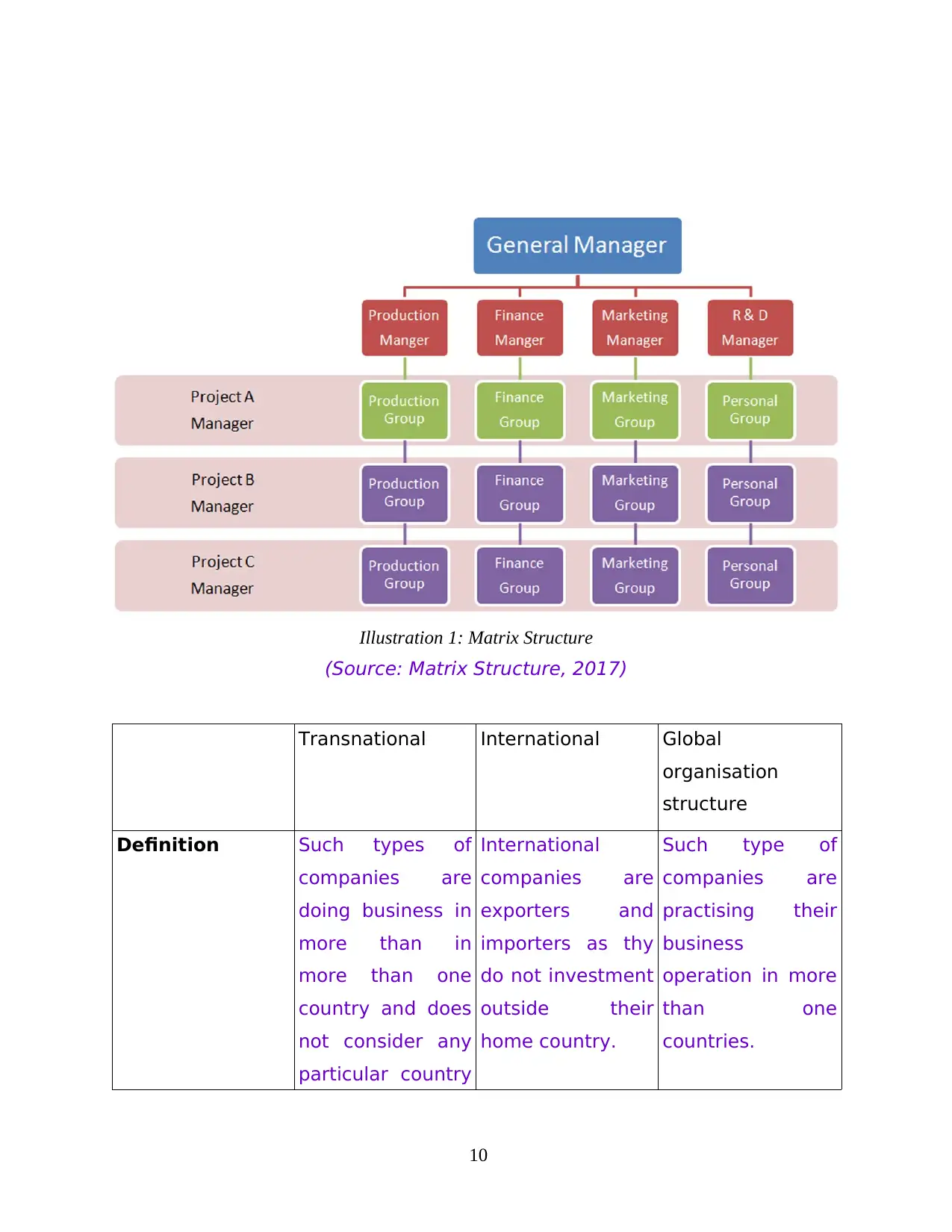
(Source: Matrix Structure, 2017)
Transnational International Global
organisation
structure
Definition Such types of
companies are
doing business in
more than in
more than one
country and does
not consider any
particular country
International
companies are
exporters and
importers as thy
do not investment
outside their
home country.
Such type of
companies are
practising their
business
operation in more
than one
countries.
10
Illustration 1: Matrix Structure
Transnational International Global
organisation
structure
Definition Such types of
companies are
doing business in
more than in
more than one
country and does
not consider any
particular country
International
companies are
exporters and
importers as thy
do not investment
outside their
home country.
Such type of
companies are
practising their
business
operation in more
than one
countries.
10
Illustration 1: Matrix Structure
⊘ This is a preview!⊘
Do you want full access?
Subscribe today to unlock all pages.

Trusted by 1+ million students worldwide
1 out of 26
Related Documents
Your All-in-One AI-Powered Toolkit for Academic Success.
+13062052269
info@desklib.com
Available 24*7 on WhatsApp / Email
![[object Object]](/_next/static/media/star-bottom.7253800d.svg)
Unlock your academic potential
Copyright © 2020–2025 A2Z Services. All Rights Reserved. Developed and managed by ZUCOL.





